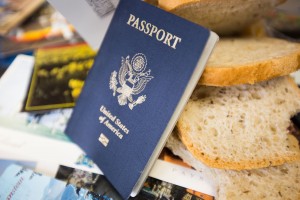
Preparing to travel can be a tricky process, especially when trying to keep a suitcase chock full of nonperishable food items under 50 pounds.
For people who eat gluten free, travel can become increasingly difficult because an extra amount of planning ahead is necessary. However, there are some solutions that can help.
Savannah Whitney, a BYU student from Washington, has several family members with Celiac disease. Celiac disease is an autoimmune disorder that affects the gastrointestinal (GI) tract. If a person with celiac disease eats gluten, it causes his or her body to attack the finger-like villi in the small intestine. These villi absorb vital nutrients. When they are attacked, nutrient deficiencies, upset stomach and a whole slew of symptoms are possible.
Whitney said her family always packs food for their travels and upon arrival they frequently call local restaurants to see what gluten-free options are offered.
In addition, Whitney said her family often visits the grocery store to avoid eating out because gluten-free eating can be expensive. “It’s better than it used to be,” Whitney said. “But it’s difficult in a place you aren’t familiar with.”
Whitney said there is a lot of prior planning required to know what family members need to bring and to make calls to let friends or family they may stay with know about their needs. “It kind of sucks, but you have to do it,” Whitney said.
Ammon Aston, a BYU student from Salt Lake City, was diagnosed with celiac disease six years ago.
Aston has traveled extensively in the last six years and said the most difficult part of traveling gluten-free is the lack of options. “Going somewhere and traveling, there’s not a whole lot of options, especially in the fast food business,” Aston said. “But they are getting better. I’ve seen a lot of progress in the last six years.”
According to Sara Bellini, a BYU professor in nutrition, dietetics and food science, gluten-free diets are somewhat of a “fad diet” right now. “We do know there are some people that are gluten sensitive but probably not as much as it does seem to be a fad diet,” Bellini said.
One positive outcome of the fad for those who are medically restrained from eating gluten has been an increased awareness. Restaurants are becoming more aware of the need for gluten-free options. “You can order things gluten-free and they can actually bring it gluten-free,” Aston said. “Before, I would order something that sounded pretty bizarre, like a hamburger without a bun.” Aston said more restaurants have created specific gluten-free menus.
Kathryn Burns, an Andavo Travel advisor in Alabama, said the higher-end resorts and restaurants seem better equipped to handle food allergies. “The more you make it aware, the better off you are,” Burns said. “You call the hotel, you tell them you have a child with food allergies, and then you make sure when you check in and you go to the various outlets to dine that your server knows that your child, or whoever, has a food allergy.”
Burns said airlines are generally accommodating when they are informed of allergies ahead of time.
Many airlines post their meal options online. Delta offers 17 “special meals” on its website for a variety of dietary restrictions, including a gluten-free option. This substitution meal is chosen upon booking a flight that offers a regular meal service. It may be wise, however, to bring gluten-free food along for long layovers because, as Aston said, there are fewer gluten-free options in the fast-food industry.
Bellini explained that people with celiac disease can’t have “any little crumb” of gluten in their diet. If a toaster has been used for regular bread, gluten-free bread can’t go in the same toaster as it can cause cross-contamination. “Cross-contamination is a big challenge,” Bellini said.
Some destinations may be more difficult than others for gluten-free travel. Many countries where diets are more rice or corn-based, such as South American or Asian areas, may be easier. Caution is still required though, as even soy sauce frequently contains gluten.
“You may need to plan ahead for availability,” Bellini said. “Communication barriers might come up and being able to explain what you need could be some of the challenge.”
Several websites, blogs and apps do offer translation cards and various tips to explain conditions and needs in different languages.
But traveling to a country where the main diet is flour-based, like France, is difficult. Eating gluten-free crepes under the Eiffel Tower may just be an almost-impossible feat.




